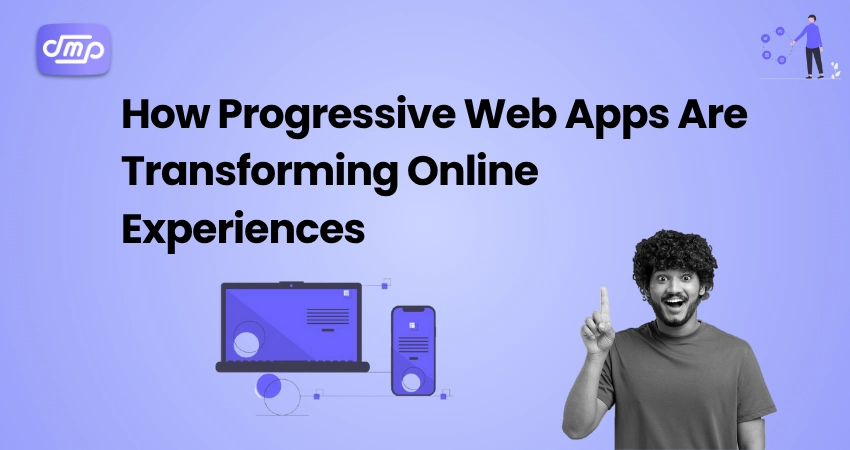
- October 3, 2025
- website design, website development
- Web development, UI/UX design
Table of Contents
In today’s digital-first world, users expect websites and apps to be fast, responsive, and accessible across devices. Traditional websites and native mobile apps often struggle to meet these expectations, resulting in slow load times, poor engagement, and abandoned sessions.
Progressive Web Apps (PWAs) are changing the game by bridging the gap between web and mobile experiences. PWAs combine the best features of websites and native apps—offering offline access, push notifications, app-like interactions, and lightning-fast performance—all without requiring downloads from app stores.
From improved conversion rates to enhanced user engagement, PWAs are transforming the way businesses connect with users online. In this guide, we’ll explore what PWAs are, their core features, benefits, and how they are reshaping online experiences for users and businesses alike.
What Are Progressive Web Apps?
Progressive Web Apps are web applications built using modern web technologies like HTML, CSS, and JavaScript that deliver app-like experiences in the browser. Unlike traditional web apps, PWAs are reliable, fast, and engaging.
Key characteristics of PWAs include:
- Progressive Enhancement: Works on any browser and device.
- Responsiveness: Adapts seamlessly to mobile, tablet, and desktop screens.
- Offline Access: Users can interact with content even without internet connectivity.
- Installability: Users can “install” a Progressive Web Apps on their device without using an app store.
Key Features of Progressive Web Apps
- Offline Functionality: Service workers allow PWAs to cache content and data, enabling users to continue browsing even when offline. This is especially valuable in regions with intermittent internet connectivity.
- Fast Load Times: PWAs use caching and efficient scripts to load instantly, reducing bounce rates and enhancing SEO performance. Google considers page speed a ranking factor, making PWAs an advantage for search visibility.
- Push Notifications: PWAs can send real-time updates to users, similar to native apps. This feature improves user engagement and retention by keeping users informed of promotions, updates, or new content.
- App-like Experience: With smooth animations, responsive layouts, and home screen access, PWAs provide a native app feel without the friction of downloads or updates.
- Cross-Platform Compatibility: PWAs are built once and run anywhere, reducing development and maintenance costs compared to creating separate iOS and Android apps.
- Automatic Updates: PWAs are always up-to-date since they fetch the latest content from the server, eliminating the need for users to manually update apps.
How Progressive Web Apps Are Improving Online User Experiences

- Enhanced User Engagement: PWAs keep users engaged with push notifications, offline access, and smooth interactions, resulting in higher retention and lower bounce rates.
Example: Flipkart, a leading Indian e-commerce platform, saw a 70% increase in conversions after implementing its PWA, thanks to faster loading and seamless offline access. - Increased Accessibility: By being device-agnostic, PWAs reach a broader audience, including users on low-end devices or slower networks. This accessibility ensures more users can interact with your content effectively.
- Faster Transactions: For e-commerce, PWAs reduce friction in checkout processes, allowing users to complete purchases quickly without app downloads.
- Improved Performance Metrics: Metrics such as Time to Interactive (TTI), Largest Contentful Paint (LCP), and Cumulative Layout Shift (CLS) improve significantly with PWAs, enhancing overall user satisfaction.
- Seamless Integration with Existing Platforms: PWAs can integrate with web platforms like Shopify, WordPress, or custom CMS solutions, enabling businesses to upgrade user experience without complete redevelopment.
Business Benefits of Progressive Web Apps
- Higher Conversion Rates: Progressive Web Apps reduce friction in user interactions, leading to increased conversion rates. Features like offline access, faster load times, and push notifications encourage users to engage and purchase.
- Cost-Effective Development: Developing a Progressive Web App is typically cheaper than building native apps for multiple platforms. One codebase works for both desktop and mobile, reducing development and maintenance costs.
- Better SEO Performance: Since PWAs are essentially websites, they are indexed by search engines, improving discoverability. Fast load times also positively impact rankings on Google.
- Increased User Retention: With home screen access, offline functionality, and push notifications, users are more likely to return to your PWA regularly, increasing brand loyalty.
- Reduced Dependence on App Stores: Progressive Web Apps bypass app stores, avoiding approval delays, commissions, and update restrictions. This allows businesses to deliver updates directly to users instantly.
Examples of Successful Progressive Web Apps
- Twitter Lite: Twitter Lite is a Progressive Web App that reduces data consumption by 70% and improves load times significantly, making it accessible to users in low-bandwidth regions.
- Starbucks: Starbucks implemented a Progressive Web App for ordering drinks offline, leading to increased engagement and orders even in areas with unreliable internet connections.
- Flipkart: Flipkart’s Progressive Web App improved conversions and reduced page load times drastically, providing an app-like experience for millions of users in India.
- Pinterest: Pinterest’s PWA boosted mobile engagement by up to 60%, with faster load times and improved offline usability.
These examples demonstrate that Progressive Web Apps can enhance performance, engagement, and conversions across industries.
Best Practices for Implementing Progressive Web Apps
- Use HTTPS: Ensure your Progressive Web App is served over HTTPS for security and trust.
- Implement Service Workers: Proper caching and background processes ensure offline usability.
- Optimize Performance: Minimize JavaScript, compress images, and leverage lazy loading.
- Responsive Design: Ensure your Progressive Web App adapts to all devices seamlessly.
- Test Regularly: Use tools like Lighthouse, PageSpeed Insights, and WebPageTest to monitor performance.
- Provide App-Like Navigation: Ensure smooth transitions, intuitive UI, and easy access to key features.
- Leverage Push Notifications Strategically: Avoid spamming; deliver relevant updates to enhance engagement.
The Future of Progressive Web Apps
Progressive Web Apps are poised to reshape the digital landscape. With mobile usage continuing to rise, PWAs offer a solution that combines speed, accessibility, and engagement.
Key trends for PWAs in 2025 include:
- Integration with AI and AR/VR experiences for interactive web applications.
- Further offline capabilities, making web apps usable even in disconnected environments.
- Enhanced push notification strategies for personalized marketing.
- Adoption by enterprise-level businesses seeking cost-effective, scalable solutions.
Businesses that adopt PWAs early will benefit from improved user experience, higher conversions, and a competitive advantage.
Conclusion
Progressive Web Apps are transforming online experiences by delivering fast, reliable, and engaging interactions that bridge the gap between traditional websites and native apps. From offline access and push notifications to improved SEO and reduced development costs, PWAs offer a compelling solution for businesses looking to thrive in the digital-first era.
By adopting Progressive Web Apps, businesses can enhance user satisfaction, boost conversions, and retain loyal customers without the complexity of managing multiple native apps. With the rise of mobile and low-bandwidth internet usage, the question is no longer whether businesses should implement PWAs—it’s how quickly they can leverage them to stay ahead.
Investing in a Progressive Web App today is an investment in future-ready online experiences that delight users and drive measurable business outcomes.











